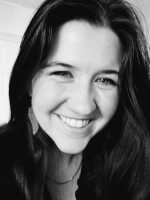Light pollution is usually associated with big towns and cities. But a new kind of light pollution map shows it鈥檚 also a problem in rural areas, including in the Mountain West.
New Mexico-based cartographer Tim Wallace, with the data visualization company Descartes Labs, recently created a map that merges nighttime light imagery and population data. That revealed 鈥渁reas that create an outsized amount of light per person living there," he on Twitter.
鈥淭here were definitely some spots in the Mountain West,鈥� Wallace said. 鈥淚n Colorado I remember one in particular where it was not labeled on Google Maps or on OpenStreetMap. You look at it overhead on high-resolution satellite imagery and it just looks like some kind of complex.鈥�
Those complexes tend to be oil and gas operations, suburbs and even greenhouses. The Bakken oil patch in western North Dakota, for example, where drillers are , is the most conspicuous cluster of light on Wallace鈥檚 map.
Greenhouses growing leafy greens and cannabis stand out, too. That rural light pollution increasingly concerns John Barentine of the International Dark-Sky Association, who says it has negative effects on wildlife.
鈥淲hether they鈥檙e plants or animals or insects, it鈥檚 all across the biological world,鈥� Barentine said. 鈥淲hich is just a reflection of the fact that our biology on this planet grew up in an environment where for billions of years there were only natural sources of light at night.鈥�
But he says simple measures like using blinds for greenhouses could mitigate the problem, helping to preserve the region鈥檚 iconic night sky for years to come.
Find reporter Madelyn Beck on Twitter
Copyright 2020 Boise State Public Radio
This story was produced by the Mountain West 暗黑爆料 Bureau, a collaboration between Wyoming Public Media, Boise State Public Radio in Idaho, KUER in Salt Lake City, KUNR in Nevada, the O鈥機onnor Center For the Rocky Mountain West in Montana, and KRCC and KUNC in Colorado.
Copyright 2020 Boise State Public Radio 暗黑爆料. To see more, visit . 9(MDAxNDQ2NDAxMDEyNzU2NzM2ODA3ZGI1ZA001))




